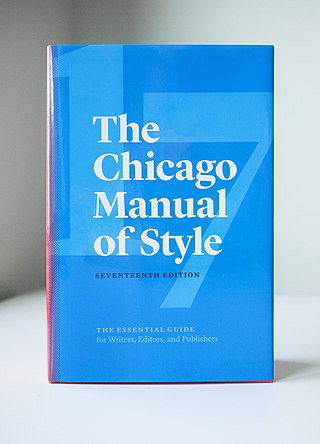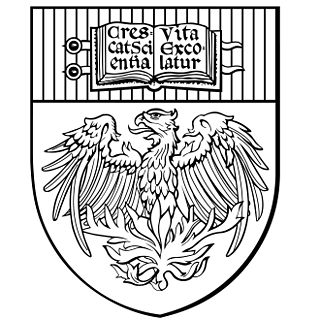
The Chicago Manual of Style is a style guide for American English published since 1906 by the University of Chicago Press. Its 17 editions have prescribed writing and citation styles widely used in publishing.

A citation is a reference to a source. More precisely, a citation is an abbreviated alphanumeric expression embedded in the body of an intellectual work that denotes an entry in the bibliographic references section of the work for the purpose of acknowledging the relevance of the works of others to the topic of discussion at the spot where the citation appears.
Reference management software, citation management software, or bibliographic management software is software that stores a database of bibliographic records and produces bibliographic citations (references) for those records, needed in scholarly research. Once a record has been stored, it can be used time and again in generating bibliographies, such as lists of references in scholarly books and articles. Modern reference management applications can usually be integrated with word processors so that a reference list in one of the many different bibliographic formats required by publishers and scholarly journals is produced automatically as an article is written, reducing the risk that a cited source is not included in the reference list. They will also have a facility for importing bibliographic records from bibliographic databases.
The International Standard Bibliographic Description (ISBD) is a set of rules produced by the International Federation of Library Associations and Institutions (IFLA) to create a bibliographic description in a standard, human-readable form, especially for use in a bibliography or a library catalog. A preliminary consolidated edition of the ISBD was published in 2007 and the consolidated edition was published in 2011, superseding earlier separate ISBDs for monographs, older monographic publications, cartographic materials, serials and other continuing resources, electronic resources, non-book materials, and printed music. In 2022, IFLA published the 2021 update to the 2011 consolidated edition, which includes expanding ISBD to include unpublished resources, integrating stipulations for the application of ISBD to the description of component parts, clarifying cartographic resources stipulations, as well as added examples and updates to the Areas and glossary sections. IFLA's ISBD Review Group is responsible for maintaining the ISBD.

Wayne Clayson Booth was an American literary critic and rhetorician. He was the George M. Pullman Distinguished Service Professor Emeritus in English Language & Literature and the College at the University of Chicago. His work followed largely from the Chicago school of literary criticism.
An outline, also called a hierarchical outline, is a list arranged to show hierarchical relationships and is a type of tree structure. An outline is used to present the main points or topics (terms) of a given subject. Each item in an outline may be divided into additional sub-items. If an organizational level in an outline is to be sub-divided, it shall have at least two subcategories, although one subcategory is acceptable on the third and fourth levels, as advised by major style manuals in current use. An outline may be used as a drafting tool of a document, or as a summary of the content of a document or of the knowledge in an entire field. It is not to be confused with the general context of the term "outline", which a summary or overview of a subject, presented verbally or written in prose. The outlines described in this article are lists, and come in several varieties.
Kate Ledgerwood Turabian was an Armenian-American, by marriage, educator who is best known for her book A Manual for Writers of Research Papers, Theses, and Dissertations. In 2018, the University of Chicago Press published the 9th edition of the book. The University of Chicago Press estimates that the various editions of this book have sold more than 9 million copies since its publication in 1937. A 2016 analysis of over one million college course syllabi found that Turabian was the most commonly assigned female author due to this book.

The University of Chicago Press is the largest and one of the oldest university presses in the United States. It is operated by the University of Chicago and publishes a wide range of academic titles, including The Chicago Manual of Style, numerous academic journals, and advanced monographs in the academic fields.
Parenthetical referencing is a citation system in which in-text citations are made using parentheses. They are usually accompanied by a full, alphabetized list of citations in an end section, usually titled "references", "reference list", "works cited", or "end-text citations". Parenthetical referencing can be used in lieu of footnote citations.

A block quotation is a quotation in a written document that is set off from the main text as a paragraph, or block of text, and typically distinguished visually using indentation and a different typeface or smaller size font. This is in contrast to setting it off with quotation marks in a run-in quote. Block quotations are used for long quotations. The Chicago Manual of Style recommends using a block quotation when extracted text is 100 words or more, or approximately six to eight lines in a typical manuscript.
Sentence spacing concerns how spaces are inserted between sentences in typeset text and is a matter of typographical convention. Since the introduction of movable-type printing in Europe, various sentence spacing conventions have been used in languages with a Latin alphabet. These include a normal word space, a single enlarged space, and two full spaces.
Scientific writing is writing about science, with an implication that the writing is by scientists and for an audience that primarily includes peers—those with sufficient expertise to follow in detail. Scientific writing is a specialized form of technical writing, and a prominent genre of it involves reporting about scientific studies such as in articles for a scientific journal. Other scientific writing genres include writing literature-review articles, which summarize the existing state of a given aspect of a scientific field, and writing grant proposals, which are a common means of obtaining funding to support scientific research. Scientific writing is more likely to focus on the pure sciences compared to other aspects of technical communication that are more applied, although there is overlap. There is not one specific style for citations and references in scientific writing. Whether you are submitting a grant proposal, literature review articles, or submitting an article into a paper, the citation system that must be used will depend on the publication you plan to submit to.

MLA Handbook, formerly MLA Handbook for Writers of Research Papers (1977–2009), establishes a system for documenting sources in scholarly writing. It is published by the Modern Language Association, which is based in the United States. According to the organization, their MLA style "has been widely adopted for classroom instruction and used worldwide by scholars, journal publishers, and academic and commercial presses".
Joseph M. Williams was a professor in the Department of English Language and Literature at the University of Chicago where he promoted clarity in writing for many years. He authored several books on language and writing.
Gregory G. Colomb was a professor of the English language and literature and director of writing programs at the University of Virginia. His research interests were in writing studies, 18th century literature, and theory.

The Craft of Research is a book by Wayne C. Booth, Gregory G. Colomb, Joseph M. Williams, Joseph Bizup, and William T. Fitzgerald. The work is published by the University of Chicago Press. The book aims to provide a basic overview of how to research, from the process of selecting a topic and gathering sources to the process of writing results. The book has become a standard text in college composition classes and is now in its fourth edition.
Sentence spacing guidance is provided in many language and style guides. The majority of style guides that use a Latin-derived alphabet as a language base now prescribe or recommend the use of a single space after the concluding punctuation of a sentence.
Nota Bene is an integrated software suite of applications, including word processing, reference management, and document text analysis software that is focused on writers and scholars in the Humanities, Social Sciences, and the Arts. The integrated suite is referred to as the Nota Bene Workstation. It runs on Microsoft Windows and Macintosh.

The Open Syllabus Project (OSP) is an online open-source platform that catalogs and analyzes millions of college syllabi. Founded by researchers from the American Assembly at Columbia University, the OSP has amassed the most extensive collection of searchable syllabi. Since its beta launch in 2016, the OSP has collected over 7 million course syllabi from over 80 countries, primarily by scraping publicly accessible university websites. The project is directed by Joe Karaganis.








